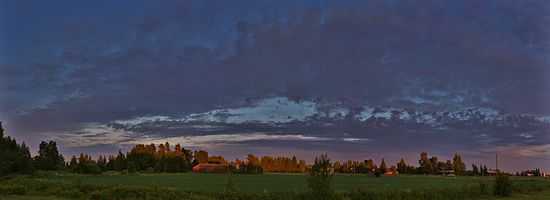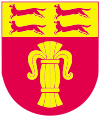Ostrobothnia (region)
| Ostrobothnia Österbottens landskap Pohjanmaan maakunta | ||
|---|---|---|
| Region | ||
| ||
 Ostrobothnia on a map of Finland | ||
| Country | Finland | |
| Historical province | Ostrobothnia | |
| Area | ||
| • Total | 7,932.36 km2 (3,062.70 sq mi) | |
| Population (2013) | ||
| • Total | 180,384 | |
| • Density | 23/km2 (59/sq mi) | |
| ISO 3166 code | FI-12 | |
| NUTS | 195 | |
| Regional bird | Common swift (Apus apus) | |
| Regional fish | Common whitefish (Coregonus lavaretus) | |
| Regional flower | European meadowsweet (Filipendula ulmaria) | |
| Website | osterbotten.fi | |
Ostrobothnia (Swedish: Österbotten; Finnish: Pohjanmaa) is a region of Finland. It is located in Western Finland. It borders the regions Central Ostrobothnia, Southern Ostrobothnia, and Satakunta and is one of the four modern regions making up the historical province of Ostrobothnia.
Ostrobothnia is one of the two Finnish regions with a Swedish speaking majority (the other being the constitutionally monolingual province of Åland); Swedish-speakers make up 51.2%.[1] The region contains both bilingual municipalities and ones that are exclusively Finnish or Swedish-speaking.
Geographically, Ostrobothnia has little topographical relief, because it is mostly former seafloor brought to surface by post-glacial rebound and the accumulation of alluvial sediment. Ostrobothnia has both vast expanses of cultivated fields (lakeus) as in Southern Ostrobothnia, and the archipelago of Kvarken (Finnish: Merenkurkku). Glacial transport has deposited large quantities of glacial erratics (rocks) in the area. Like elsewhere in Pohjanmaa, rivers are a prominent part of the landscape. The major rivers that discharge into the Gulf of Bothnia in Ostrobothnia are Kyrönjoki, Lapuanjoki and Ähtävänjoki.
The regional tree is the black alder (Alnus glutinosa), the regional mammal is the common elk (Alces alces alces), the regional stone is the Vaasa granite and the regional song is "The march of Vaasa" (Swedish: Vasamarschen, Finnish: Vaasan marssi).
In local circles or communities, Ostrobothnia is often referred to as "Pampas" and a person from Ostrobothnia is called a "Pampees".[2] The word derives from the similarities in the flat landscape with the Pampas area in southern America.
Municipalities
There are 15 municipalities in Ostrobothnia region. Cities and towns are marked in bold, and the links are only in the majority language names.
| Name in Finnish | Name in Swedish | Population[3] | Swedish speakers[4] | Finnish speakers[4] |
|---|---|---|---|---|
| Isokyrö | Storkyro | 4,855 | 0.6% | 98.9% |
| Pietarsaari | Jakobstad | 19,603 | 56.4% | 40.2% |
| Kaskinen | Kaskö | 1,329 | 28.1% | 68.1% |
| Mustasaari | Korsholm | 19,261 | 70.2% | 28.7% |
| Korsnäs | Korsnäs | 2,223 | 91.2% | 3.2% |
| Kristiinankaupunki | Kristinestad | 6,854 | 56.6% | 42.2% |
| Kruunupyy | Kronoby | 6,657 | 83.3% | 15.6% |
| Laihia | Laihela | 8,064 | 1% | 98.3% |
| Luoto | Larsmo | 5,097 | 92.5% | 6.5% |
| Maalahti | Malax | 5,583 | 88.2% | 9.1% |
| Närpiö | Närpes | 9,385 | 88.4% | 5.8% |
| Uusikaarlepyy | Nykarleby | 7,537 | 89.3% | 8.1% |
| Pedersöre | Pedersöre | 11,047 | 90.1% | 9% |
| Vaasa | Vasa | 67,034 | 24.8% | 69.8% |
| Vöyri | Vörå | 6,719 | 84.6% | 13.6% |
Former municipalities:
- The current Vörå is the result of consolidation of Maxmo (Finnish: Maksamaa) and Oravais (Finnish: Oravainen).
- Nykarleby (Finnish: Uusikaarlepyy) has been merged with Jeppo (Finnish: Jepua).
- Korsholm (Finnish: Mustasaari) has been consolidated from the five municipalities of Korsholm, Solf, Replot, Björköby and Kvevlax.
- Pedersöre has the former Finnish name Pietarsaaren maalaiskunta (see maalaiskunta).
Heraldry

The sprouting wheatsheaf is a symbol of the Royal House of Vasa; a Vasa king established the city of Vaasa, the capital of the region. The running weasels are a symbol of Ostrobothnia.
See also
- Swedish dialects in Ostrobothnia
- Katrina (novel) (about an Ostrobothnian woman)
References
- ↑ Väestö iän ja sukupuolen mukaan alueittain 31.12.2008. Tilastokeskus: demography.
- ↑ http://urbaanisanakirja.com/word/pampees/
- ↑ "VÄESTÖTIETOJÄRJESTELMÄ REKISTERITILANNE 30.11.2014" (in Finnish and Swedish). Population Register Center of Finland. Retrieved 29 December 2014.
- ↑ 4.0 4.1 "Population according to language and the number of foreigners and land area km2 by area as of 31 December 2008". Statistics Finland's PX-Web databases. Statistics Finland. Retrieved 29 March 2009.
External links
![]() Media related to Ostrobothnia at Wikimedia Commons
Media related to Ostrobothnia at Wikimedia Commons
| ||||||||||||
